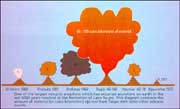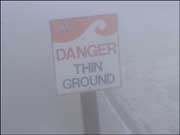3. Geology
The Main events of the Taupo Volcanic Zone have been
- About a million years ago a large lake extended from Taupo to present day Reparoa. The lake bed was composed of muddy sediments that became mudstones.
- The lake was destroyed about 26 000 years ago when a massive volcanic eruption blew 800 cubic kilometres of rock into the earth's atmosphere.
- In 186 AD (1820 years ago) another massive explosion blew a further 100 cubic kilometres of rock into the earth's atmosphere from what is now Lake Taupo
This sequence is important in producing the following rock formations:
- A mudstone cap rock from the Taupo-Reparoa lake that now traps steam and water
- Layers of porous volcanic rocks such as Andesite and Rhyolite which allow water to flow through them. These rocks are typically 20 % porous which allows the hot water and steam to be held in them
- Large pools of magma that lie close beneath the rocks and heat them.
- A series of fault planes which allow the steam and water to move up and along to the North East. These fault planes are the result of stretching of the crust in the Taupo area.
The Resistivity Boundary
Geologists use many techniques to decide where geothermal water can be found. One of these techniques, resistivity measurements, is particularly useful.
Resistivity is a measure of how hard it is for electricity
to flow through a substance.
The less the resistivity, the greater the flow of electricity. Because
hot underground water contains many dissolved salts electricity will
flow easily through it and will therefore have a 'low ' resistivity.
Where the resistivity increases it marks the outer limit of hot water in a geothermal field. This change is known as the Resistivity Boundary.




